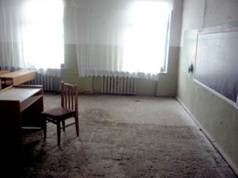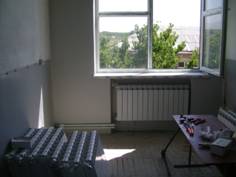2010-2011 – Renovation of the School in Ditak Village – stage 1
Ditak village school, Ararat region, Armenia
Background
The Ditak village community has a secondary school built in 1967 that provides education to nearly 90 pupils aged from 6 to 17 years. During the last three years, the number of children enrolled in the school has shown a stable increase. Each of 10 grades includes 8 to 14 pupils. Of the 17 teachers working in the school, the majority are women (14).
During a visit to the village school in 2009, AWHHE staff were shocked to see the school management and staff working hard to provide the best possible education to children in very difficult conditions with the lack of normal heating, poor sanitation, broken windows and floors, as well as unhealthy state of building materials. In this state the school had to function in the conditions of dry continental climate with very hot summer (+40 C0) and cold winter (-15 C0) and a heating season lasting from November to March. Although the school had two blocks, the learning process took place only in the main two-storied block where all the classrooms and administration operated. The backblock which was originally meant for a gymnasium and a kindergarten did not function due to disastrous state as a result of constant flooding during the irrigation period. Since the land parcel where the school building is located is mainly surrounded by agricultural land fields, during the irrigation period the level of the ground water flashed up to 1 meter and higher flooding the premises located below ground level (mainly the gym). The primitive draining trench at one edge of the school yard that existed then could not protect the building.
AWHHE commitment
Having discussed the situation with the village and school management, AWHHE made a commitment to assist them in improving the learning environment in the school. The architectural company Quelque-chose LLC was asked to develop a reconstruction plan for the school. With all this information ready, AWHHE launched an appeal to donors.
Donor response:
The Government of Japan through the Embassy of Japan to Armenia: USD 104’200
Swiss “Sourire vers l’Avenir” Foundation: EUR 2000
“A.R.M.E. – firm” producers’ co-operative: USD 4405
AWHHE: USD 2500
Regional Government of Ararat: AMD 18’000’000 (~$48’000)
RESULTS OF THE FIRST STAGE
Other pending urgent works
To provide children with normal educational conditions, following building activities to be implemented urgently
- Provide the effective drainage of surface (irrigation) water from the School’s land parcel.
- Strengthen the wooden construction and exchange the roof covering of the Rest of the building to profiled metal sheets and eliminate further use of dangerous Asbestos slate.
- Build new floor and bring new finishes to the Gym walls
- Completely renew the lining and floor coverings of all premises and in the connecting corridor.
- Exchange all interior doors to solid doors with built-in locks.
- Repair damaged plastering.
- Build urine dry diverting toilet (the lack of drinking water makes conventional toilets unreasonable.) adjacent to the connecting corridor with the entrance from that corridor. Provide water for hands washing.









